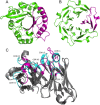Why reinvent the wheel? Building new proteins based on ready-made parts
- PMID: 26821641
- PMCID: PMC4918424
- DOI: 10.1002/pro.2892
Why reinvent the wheel? Building new proteins based on ready-made parts
Abstract
We protein engineers are ambivalent about evolution: on the one hand, evolution inspires us with myriad examples of biomolecular binders, sensors, and catalysts; on the other hand, these examples are seldom well-adapted to the engineering tasks we have in mind. Protein engineers have therefore modified natural proteins by point substitutions and fragment exchanges in an effort to generate new functions. A counterpoint to such design efforts, which is being pursued now with greater success, is to completely eschew the starting materials provided by nature and to design new protein functions from scratch by using de novo molecular modeling and design. While important progress has been made in both directions, some areas of protein design are still beyond reach. To this end, we advocate a synthesis of these two strategies: by using design calculations to both recombine and optimize fragments from natural proteins, we can build stable and as of yet un-sampled structures, thereby granting access to an expanded repertoire of conformations and desired functions. We propose that future methods that combine phylogenetic analysis, structure and sequence bioinformatics, and atomistic modeling may well succeed where any one of these approaches has failed on its own.
Keywords: Rosetta; antibody; bioinformatics; evolution; protein design; β-propeller; β/α barrel.
© 2016 The Protein Society.
Figures




Similar articles
-
Practically useful protein-design methods combining phylogenetic and atomistic calculations.Curr Opin Struct Biol. 2020 Aug;63:58-64. doi: 10.1016/j.sbi.2020.04.003. Epub 2020 Jun 5. Curr Opin Struct Biol. 2020. PMID: 32505941 Free PMC article. Review.
-
Evolution-Inspired Computational Design of Symmetric Proteins.Methods Mol Biol. 2017;1529:309-322. doi: 10.1007/978-1-4939-6637-0_16. Methods Mol Biol. 2017. PMID: 27914059
-
Computational tools for designing and engineering biocatalysts.Curr Opin Chem Biol. 2009 Feb;13(1):26-34. doi: 10.1016/j.cbpa.2009.02.021. Epub 2009 Mar 16. Curr Opin Chem Biol. 2009. PMID: 19297237 Review.
-
Design of protein catalysts.Annu Rev Biochem. 2013;82:447-70. doi: 10.1146/annurev-biochem-072611-101825. Annu Rev Biochem. 2013. PMID: 23746259 Review.
-
Current updates on computer aided protein modeling and designing.Int J Biol Macromol. 2016 Apr;85:48-62. doi: 10.1016/j.ijbiomac.2015.12.072. Epub 2015 Dec 28. Int J Biol Macromol. 2016. PMID: 26730484 Review.
Cited by
-
Optimizing antibody affinity and stability by the automated design of the variable light-heavy chain interfaces.PLoS Comput Biol. 2019 Aug 23;15(8):e1007207. doi: 10.1371/journal.pcbi.1007207. eCollection 2019 Aug. PLoS Comput Biol. 2019. PMID: 31442220 Free PMC article.
-
A roadmap for biocatalysis - functional and spatial orchestration of enzyme cascades.Microb Biotechnol. 2016 Sep;9(5):601-9. doi: 10.1111/1751-7915.12386. Epub 2016 Jul 15. Microb Biotechnol. 2016. PMID: 27418373 Free PMC article. Review.
-
Highly active enzymes by automated combinatorial backbone assembly and sequence design.Nat Commun. 2018 Jul 17;9(1):2780. doi: 10.1038/s41467-018-05205-5. Nat Commun. 2018. PMID: 30018322 Free PMC article.
-
What Have We Learned from Design of Function in Large Proteins?Biodes Res. 2022 Mar 8;2022:9787581. doi: 10.34133/2022/9787581. eCollection 2022. Biodes Res. 2022. PMID: 37850148 Free PMC article. Review.
-
Computational Protein Design with Deep Learning Neural Networks.Sci Rep. 2018 Apr 20;8(1):6349. doi: 10.1038/s41598-018-24760-x. Sci Rep. 2018. PMID: 29679026 Free PMC article.
References
-
- Hecht MH, Richardson JS, Richardson DC, Ogden RC (1990) De novo design, expression, and characterization of Felix: a four‐helix bundle protein of native‐like sequence. Science 249:884–891. - PubMed
-
- Regan L, DeGrado WF (1988) Characterization of a helical protein designed from first principles. Science 241:976–978. - PubMed
Publication types
MeSH terms
Substances
Grants and funding
LinkOut - more resources
Full Text Sources
Other Literature Sources

